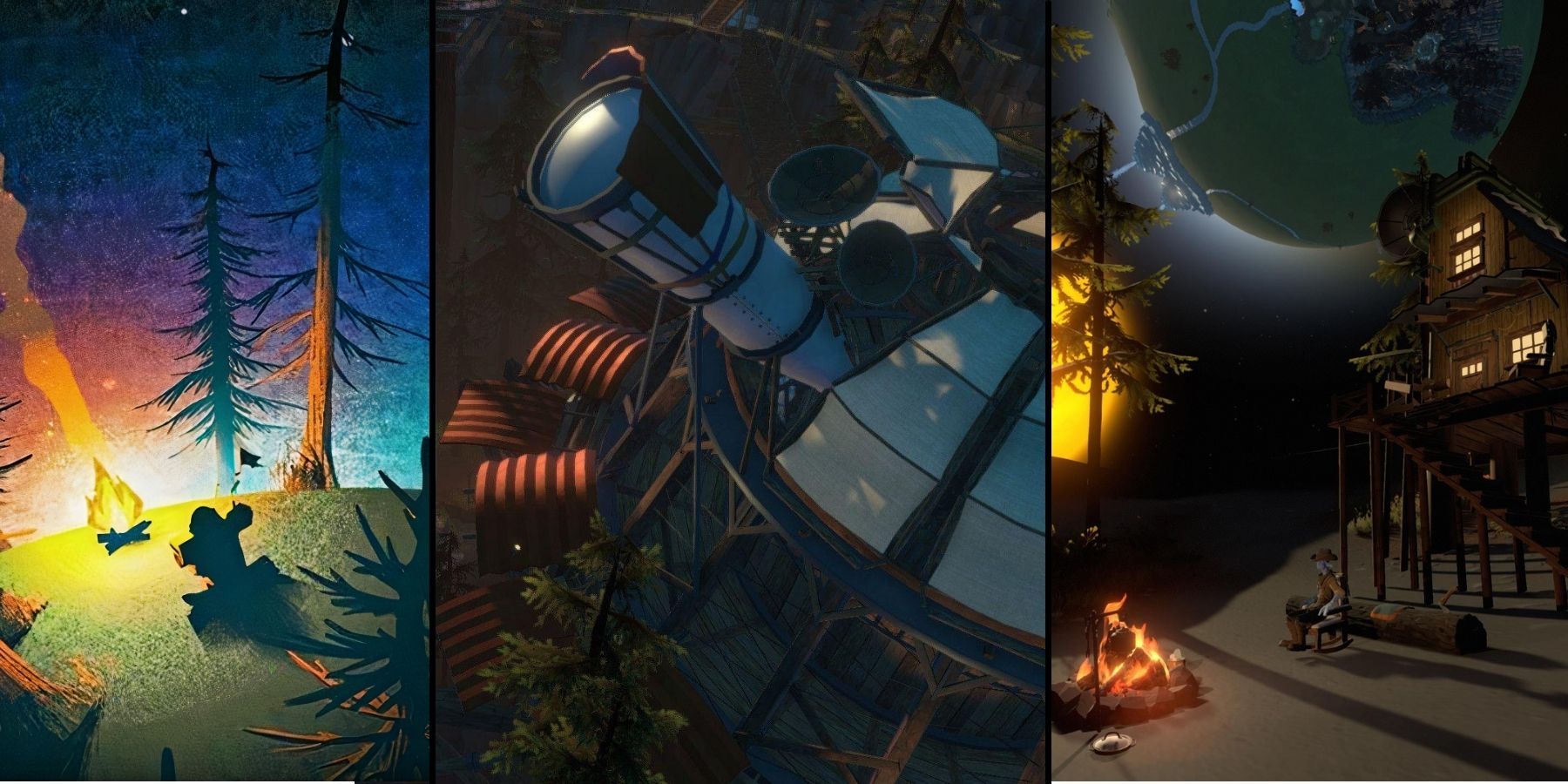The Best Games That Are Hard To Explain
Description
Summary
- Games like Baba Is You challenge players to rewrite reality through clever word puzzles & creative thinking.
- Return of the Obra Dinn offers a unique detective experience using frozen moments & deductive reasoning.
- Undertale’s deep storytelling mechanics teach empathy through player choices that impact the game world.
Some games just don’t come with an elevator pitch. They sound bizarre on paper, confusing in conversation, and downright unmarketable if judged by a screenshot alone. But the second someone actually plays them, everything clicks—or at least becomes compelling enough that none of that confusion matters.

Related
10 Video Game Storylines That Are Impossible To Follow
Video games can possess fantastic stories, but certain games have storylines that are so convoluted, no gamer could possibly follow along with it.
These are the kind of games players finish, think about for weeks, and then recommend to everyone they know with nothing more than a wide-eyed “just trust me.” They dodge genre labels, warp expectations, and twist gameplay mechanics into shapes so weirdly satisfying, they defy traditional explanations. Yet somehow, they’re also some of the most beloved experiences out there.
8
Baba Is You
“Is” Can Be A Verb, A Wall, And A Win Condition
On the surface, it looks like a Sokoban puzzle dragged out of a kindergarten whiteboard session, but Baba Is You is quietly one of the most brain-melting logic experiments ever stuffed into a grid. It starts simple: move the little sheep-like thing towards a flag. But then the words start rearranging, and suddenly “Wall Is Stop” becomes “Wall Is You,” and now players are controlling every wall on the map at once. It’s less about solving puzzles and more about rewriting the rules of reality using nothing but sentence fragments and stubborn creativity.
The brilliance is in how Baba Is You never breaks its own rules, but forces players to completely unlearn theirs. There’s no traditional story, no escalating combat, just wordplay puzzles that would make a linguistics professor weep. Explaining it to someone who hasn’t played it is like trying to explain quantum physics using fridge magnets. But for those who enjoy being deeply confused in a good way, it’s a perfect recommendation.
7
Return Of The Obra Dinn
A Detective Game Where Everyone Is Dead And Time Is Your Sketchpad
Most detective games rely on dialogue trees and glowing clues. Return of the Obra Dinn throws that playbook overboard and hands players a monochrome insurance ledger instead. Set aboard an abandoned 19th-century merchant ship, it tasks players with figuring out what happened to all 60 souls who died onboard. The twist? Players can jump into frozen moments of each person’s death using a magical pocketwatch, and piece together their fate from snippets of dialogue, ambient sounds, and environmental details.
Every deduction is manual. No hints. No auto-solving. The black-and-white 1-bit art style hides more than it reveals, so players have to squint at tattoos, pick up on accents, and notice the placement of shadows, all just to figure out a name. Explaining how this jigsaw of deaths becomes one of the most satisfying whodunits in gaming sounds like a stretch. However, for those who love slow, obsessive problem-solving, it’s an instant recommendation.
6
Undertale
A Game That Teaches Empathy Using Bullets, Jokes, And A Flower
It looks like a lost SNES game, it sounds like a Game Boy with feelings, and it plays like a joke. Until it doesn’t. Undertale wears its weirdness like armor—players can flirt with skeletons, spare enemies mid-battle, or get absolutely wrecked by a power-hungry childlike flower. But buried beneath the memes and the MIDI tones is a system that tracks morality in ways most RPGs wouldn’t dare.
Every decision matters. Enemies remember how they were treated. Save files lie to the player. Killing something doesn’t make the game harder—it makes it sadder. The mechanics are simple, but the storytelling is layered with meta commentary that borders on philosophical. It’s easy to tell someone that Undertale is good. What’s harder is explaining how the game rewires the player’s sense of responsibility, and how no two playthroughs feel the same, especially if they try to do a Genocide run and find out what “no mercy” really means.
5
The Stanley Parable
The Game That Explains Itself, Mocks You For It, And Then Changes The Ending
Narrated by a British voice that sounds like it’s judging the player’s every move, The Stanley Parable is less a game and more a metaphysical argument disguised as an office simulator. The story begins with Stanley discovering that everyone at his workplace is gone. What happens next depends entirely on how obedient or chaotic the player feels. Follow the narrator’s instructions? The story unfolds one way. Disobey him? He might get annoyed, confused, or existentially distraught.

Related
The Stanley Parable: Ultra Deluxe – 8 Best Additions To The Original Game
The Stanley Parable Ultra Deluxe has brought the groundbreaking indie game back with more content for players to explore.
There’s no clear goal. Every ending contradicts another. The narrator comments on player choice while simultaneously being affected by it. At one point, he restarts the game because the player won’t listen. The Stanley Parable is part comedy, part critique, and part breakdown of how video games work. Telling someone it’s a masterpiece is easy. Explaining how walking into the wrong door ruins the narrator’s whole week? Not so much.
4
Everything
Play As Everything. Literally
There’s no protagonist. There’s no level design. There’s not even a “win” condition in the traditional sense. Everything is a playable philosophy lesson disguised as a surreal sandbox where players can take control of anything from a pinecone to a galaxy. One moment, they’re a bear floating through a forest. The next, they’re a quark. The next, an idea. It sounds like nonsense. It is nonsense. However, it’s also quite profound.
The narration, voiced entirely by philosopher Alan Watts, reinforces this feeling of cosmic unity by gently nudging players to reflect on scale, identity, and being. There’s a button to make objects roll. Every object just somersaults awkwardly. Nothing about Everything follows any rule of conventional game design, and yet it sticks with people. Recommending it feels like a dare, but for those who try it, it often becomes one of those rare experiences that shifts perspective, even if they can’t quite say why.
3
Death Stranding
A Cargo Delivery Simulator That’s Somehow About Love, Loss, And Terrain Grades
When Hideo Kojima pitched Death Stranding as a walking simulator where the player delivers packages across post-apocalyptic America, people weren’t sure if it was performance art or a prank. Turns out it was neither—it was something stranger. Yes, players spend most of their time hauling boxes through mountains and rivers while monitoring their stamina and balancing their load like a Jenga tower, but that’s not the point. The real game is about connection.

Related
10 Most Shocking Moments From Death Stranding, Ranked
Death Stranding is a strange game, one filled with scenes that leave a lasting impression. Here are the most shocking moments in Kojima’s game.
Every ladder left behind, every bridge built by another player, forms a quiet, invisible web between thousands of people working together without ever meeting. The slow, plodding traversal, the awkward falls, the way Norman Reedus grunts when he trips—they all feed into a sense of hard-earned progress and emotional investment. It shouldn’t work. It does. And trying to explain that without sounding like a Kojima acolyte is a nearly impossible task. But recommending it? That’s easy—just tell people it’s the best game about hiking with anxiety and ghosts ever made.
2
Katamari Damacy Reroll
When Rolling Up The World Just Feels Right
There’s no smooth segue into a game where a tiny space prince rolls up cows, continents, and entire countries into a ball to rebuild the stars. Katamari Damacy Reroll is absurd in every way—from its offbeat music to its pastel-colored chaos—but it’s also one of the most oddly therapeutic games out there. The core mechanic is simple: roll a sticky ball over objects to make it bigger. That’s it. But the sheer escalation of scale, from paperclips to skyscrapers, never stops being delightful.
Trying to explain the emotional depth of something so mechanically silly feels like a contradiction, yet there’s a weirdly touching subtext under the chaos. The King of All Cosmos constantly belittles the player while narrating in low, monotone royalty-speak. The game somehow reflects on consumerism, scale, and neglectful parenting without ever explicitly stating it. Recommending it is easy. Explaining it? Only slightly easier than explaining how a duck, a bus, and Mount Fuji ended up in a space orb.
1
Outer Wilds
A Time Loop Where Curiosity Is Both The Puzzle And The Answer
What starts as a quiet space exploration sim ends with existential revelations that could melt a blackboard. In Outer Wilds, players take control of an alien astronaut in a handcrafted solar system locked in a 22-minute time loop. Every loop ends with a supernova. The only thing that carries over is knowledge. No upgrades, no gear—just information. That mechanic alone makes it almost impossible to categorize, let alone explain.
Every planet has a mystery, every clue leads somewhere, and most answers just raise more questions. Players are rewarded not for how well they play, but how carefully they think. There’s no hand-holding, no map markers; just a ship, a suit, and an entire star system full of riddles. Describing Outer Wilds often sounds like word salad: “You need to die on purpose to learn how the sun station failed to activate a black hole before the anglerfish wake up.” But people who play it come back changed, and usually with stars in their eyes.

More
11 Beginner Tips for Outer Wilds You Should Know
Outer Wilds can be intimidating to some who don’t enjoy time restraints, but with some simple tricks, it can become a peaceful exploration journey.




